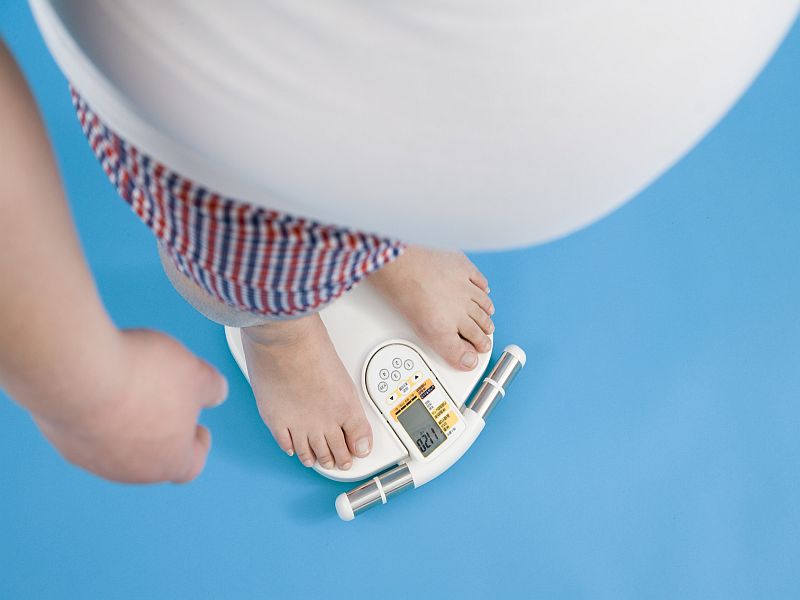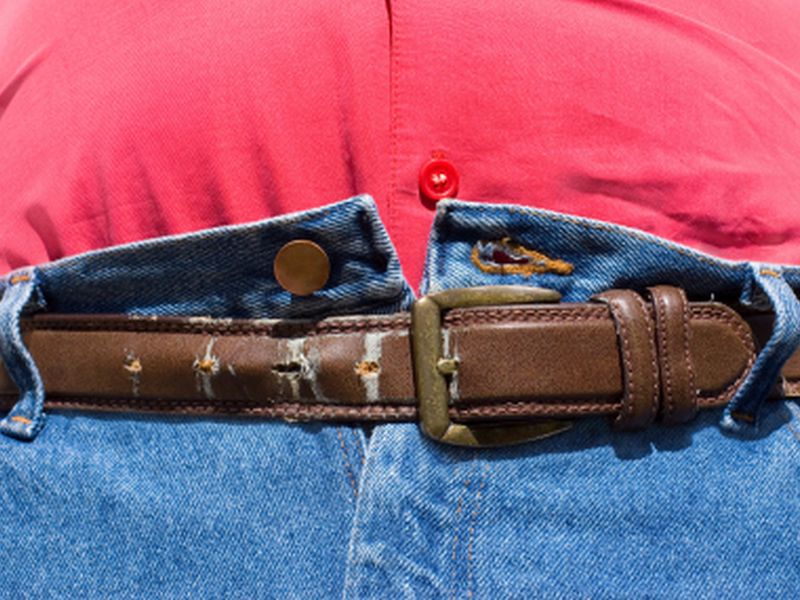|
Obesity's a Larger Problem in Rural America
 By Dennis Thompson
By Dennis ThompsonHealthDay Reporter
THURSDAY, June 14, 2018 (HealthDay News) -- Fast food and processed foods trigger deep-seated instincts in the human brain that likely promote overeating, a new study suggests.
These modern foods, high in both fat and carbohydrates, produce a higher "reward" signal than foods containing either mostly fat or mostly carbs, the researchers report.
As a result, these foods hijack your body's signals that govern food consumption, explained senior researcher Dana Small, director of Yale University's Modern Diet and Physiology Research Center.
"These foods that have both fat and carbohydrate are tricking this ancient mechanism, so the response is larger than it should be for the amount of energy that's actually there," Small said. "They're more reinforcing than they should be."
It's been known for some time that the gut sends signals to the brain that govern whether you feel hungry or full.
However, newer research has indicated that fats and carbohydrates might send these signals through separate pathways to the brain, potentially creating a combined effect, Small said.
"We wondered if it's not the case that if you have foods that have fat and carbohydrates, they might be more rewarding than equally caloric foods that contain primarily fat or primarily carbohydrates," Small said.
This is particularly a problem for modern humanity, and potentially an explanation of the twin epidemics of obesity and diabetes, she said.
"In the modern food environment, the vast majority of foods are high in both fat and carbohydrate," Small said. "In nature, these sorts of foods don't exist. You don't really find foods that are high in both fat and carbohydrates."
For the study, test participants underwent brain scans while being shown photographs of familiar snacks.
The snacks were either high in carbs (lollipops or candy), high in fats (meatballs or cheeses), or high in both (cookies or cakes), Small said.
The participants were asked to "bid" for the foods they preferred using real money, and told that if they won the auction they would be allowed to eat the item they selected, Small said.
The participants were willing to pay more for those foods that combined fat and carbohydrates, the researchers reported.
Additionally, foods featuring a fat-carb combo lit up neural circuits in the brain's reward center more than the person's favorite food, foods that appeared either sweeter or more energy-dense, or foods that came in larger quantities, the researchers found.
"What is surprising is it's not just more calories equal more reward," Small said.
The researchers also found distinct differences in people's ability to estimate calories in foods that were either heavy in fats or carbohydrates, Small said.
"People were really good at estimating how many calories were in fat, but they were terrible at estimating how many calories were in different carbohydrate foods," Small said. "When you add them together, they were no longer able to provide an accurate estimate."
These findings jibe with suggestions that snacks like nacho-flavored chips are foods perfectly engineered to push your buttons, containing "the right combo of fat, carb and salt," said Dr. Mitchell Roslin, chief of obesity surgery at Lenox Hill Hospital in New York City.
"This study explains that the body has limited skills to sense when enough is enough and why you eat the whole bag," Roslin said. "The bottom line is that we need to be educated consumers. We must make proper choices, and cannot just allow our hunger and satiety to guide us."
Mascha Davis, a registered dietitian and nutritionist in Los Angeles, urges her clients to get around these urges by keeping healthy snacks close at hand that contain carbs and fats, such as nut butters or trail mixes or bars featuring nuts and dried fruit.
"You're getting both the fat and the carbs, and that's satisfying you so you're not falling prey to the temptation of fast food or processed food," Davis said. "We may still have certain caveman tendencies, but we no longer live in a caveman landscape where it was feast or famine and sometimes there weren't plenty of options around."
The new study was published June 14 in the journal Cell Metabolism.

Copyright © 2018 HealthDay. All rights reserved.
SOURCES: Dana Small, Ph.D., director, Modern Diet and Physiology Research Center, Yale University, New Haven, Conn.; Mitchell Roslin, M.D., chief, obesity surgery, Lenox Hill Hospital, New York City; Mascha Davis, R.D.N., M.P.H., registered dietitian and nutritionist, Los Angeles; June 14, 2018, Cell Metabolism
 By Len Canter
By Len CanterHealthDay Reporter
THURSDAY, June 21, 2018 (HealthDay News) -- Dietingcan be hard on your social life.
You might think it's easier to avoid social events like cocktail parties and even family gatherings because of the temptation to overeat. But there's no reason to deny yourself the joy of being with friends and loved ones when simple tricks will help you stay on course with your diet and still have a great time.
The first rule is don't arrive ravenous. That will just make it harder to eat smart when facing tempting food. Take the edge off hunger before you go out with a healthy snack that's high in fiber, such as whole grain crackers with avocado slices or an ounce of nuts.
Once at the party, make it harder to grab food by holding a glass of seltzer in one hand. Take a sip every time a tray of hors d'oeuvres goes by. You don't have to deny yourself all treats, but it's easy to lose count if you take a tidbit from every platter that's offered.
Decide on two or three nibbles of more indulgent food. In general, your calories will go farther if you stay away from hot canapes, which are often pastry-based. Instead choose protein choices, like shrimp and chicken. If a cocktail hour will be followed by a full meal, focus on low-calorie fill-ups like raw vegetables, but skip the dip.
If the food is set up as a buffet, the rule here is to fill one plate with small portions of the items you really want to try and then move to another part of the room. Circulate and focus on the people rather than going back for a refill. It's a difficult behavior shift to make, but one that's essential in relearning priorities that minimize the emphasis you put on food.
Bonus tip: Offer to help your host with clean-up -- keeping busy will keep you from overeating and give you "favored guest" status.

Copyright © 2018 HealthDay. All rights reserved.
Why Obese People Find It So Tough to Slim Down
 By Alan Mozes
By Alan MozesHealthDay Reporter
WEDNESDAY, June 20, 2018 (HealthDay News) -- Obesity is no picnic for those who struggle with it, but new research sheds some light on why so few ever find their way to a healthy weight.
It turns out that overweightand obese folks hold starkly different views on diet and exercise than their normal-weight peers, the study found. Namely, taste is their top consideration when choosing what to eat, nutritional labels are rarely examined, and their relationship with food tends to be more impulsive and emotional.
And while many were open to the idea of smaller meal portions, they were on the other hand less likely to exercise than normal-weight people.
Cost was also a factor, with many believing that healthier foods were more expensive.
What does all this mean for public health efforts to tackle America's obesity epidemic?
"A major disparity exists between food-related policies and the mindsets and motivations of the people these policies are designed to impact," said report author Hank Cardello. He is director of the Hudson Institute's Food Policy Center in Washington, D.C.
"Previous Hudson Institute studies have confirmed that healthier items are where the [food product] growth is coming from," Cardello stressed.
But that trend just doesn't seem to apply to overweight and obese Americans, whose "eating patterns and attitudes reflect the more traditional consumer mindsets exemplified in the '70s and '80s," he explained.
"This suggests that the traditional educational approaches, which attempted to change eating behaviors, would not be effective," Cardello added.
In the survey, the 2,000 respondents fell into four categories: healthy weight (BMI 18.5 to 24.9); somewhat overweight (BMI 25 to 27); mostly overweight (BMI 27.1 to 29.9); and obese (BMI of 30 and up).
Food attitudes varied widely across the groups.
While 44 percent of the healthy weight group said that health and nutrition was a top three concern when buying food, that figure fell steadily as weight status rose. Only a third of the most obese participants felt the same.
Nearly two-thirds (62 percent) of the most obese respondents admitted knowing they should eat healthier but not doing so. And they were more likely to ignore nutritional labels, and to opt for snacks, chips, pastries, baked goods, ice cream, cookies and soda.
They were also less likely to avoid sweeteners or look for natural non-caloric sweeteners.
On the positive side, although 60 percent said they wouldn't give up snacks or sodas, they did say they'd prefer smaller portion sizes.
But cost was cited by about half of the most overweight and obese participants as a reason for not buying healthier food. And the healthy group was both wealthier and better educated.
Physical activity was also an issue. One-quarter of the most obese group never exercised, compared with 15 percent of the healthy group, the investigators found.
Cardello's findings were published in June in a Hudson Institute report.
"The historical 'mass marketed' message to eat healthier and exercise is doomed to failure for these vulnerable populations," Cardello concluded.
"For example, labeling alone is not getting the job done," he said, calling for a greater effort "to determine the best ways to communicate to the mostly overweight/obesity cohorts to identify the optimal way(s) to drive consumption of better-for-you items."
Lona Sandon is program director of the department of clinical nutrition with the School of Health Professions at the University of Texas Southwestern Medical Center at Dallas.
She expressed little surprise at the findings, noting "it is a well-known phenomenon that more knowledge and education does not necessarily change behavior."
Sandon added that "much of health messaging is about education and awareness. This may only change the behavior of a few people -- people who believe that it will make a difference."
And, "because reversing obesity is rather difficult to do, people may have tried unsuccessfully to lose weight by eating differently or adding exercise. When their strategy does not work, they perceive those behaviors to be useless," she explained.
"Overweight and obesity is a social/cultural issue as much as it is a personal behavior issue," Sandon said. "This means changing how we build cities, work environments, food industry, etcetera. It needs to go beyond awareness and education."

Copyright © 2018 HealthDay. All rights reserved.
SOURCES: Hank Cardello, MBA, senior fellow and director, Food Policy Center, Hudson Institute, Washington, D.C.; Lona Sandon, PhD, RDN, LD, program director and assistant professor, department of clinical nutrition, School of Health Professions, University of Texas Southwestern Medical Center at Dallas; June 2018, Hudson Institute, report
Warning Labels Can Scare Folks Away From Sugary Drinks

They conducted a study in the cafeteria of a hospital in Massachusetts. Three different types of labels were displayed one at a time for a few weeks near the bottled and fountain beverages. The labels were: text warnings on the health risks of sugary drinks, graphic warnings on the same, or a listing of calories in the drinks.TUESDAY, June 19, 2018 (HealthDay News) -- People are less likely to buy sugary drinks if they see warning labels that include graphic pictures of health consequences such as obesity, diabetes and tooth decay, researchers report.
When the graphic warning labels were posted, there was a nearly 15 percent drop in sugary drink sales, and consumers appeared to substitute bottled water for sugary drinks. The average calories per drink sold decreased from 88 calories to 75.
The text-only warning labels and calorie labels had no effect on sales of sugary drinks, according to the Harvard University study published online June 18 in the journal Psychological Science.
"Warning labels have been around a long time for tobacco products, but they're a new concept for sugary drinks," said study co-lead author Grant Donnelly, an assistant professor of marketing at Ohio State University and a former doctoral student at Harvard Business School.
"Text warning labels have been passed in San Francisco and are being considered in many jurisdictions in the U.S. and around the world. Ours is the first study to evaluate the effectiveness of sugary drink warning labels in the field," Donnelly explained in a Harvard news release.
"Sugar-sweetened beverages are the largest source of added sugars in the American diet and reducing intake of these beverages could improve population health," said study co-lead author Laura Zatz, a doctoral student in the departments of nutrition and social and behavioral sciences at Harvard's School of Public Health.
"As policymakers search for ways to reduce excess consumption of sugary drinks, graphic warning labels merit consideration as a tool that can empower consumers with salient information to encourage healthier choices," she said.
-- Robert Preidt

Copyright © 2018 HealthDay. All rights reserved.
How to Keep a Diet Diary
 By Len Canter
By Len CanterHealthDay Reporter
TUESDAY, June 19, 2018 (HealthDay News) -- To some people, keeping a food diary might seem old hat or just another busy-work task on your diet to-do list. But when done correctly (and diligently), it's a very effective tool for losing weight and keeping it off.
Studies show that dieters who monitor their eating and weight the most consistently achieve the most weight loss. Essentials include writing down everything you eat and drink, and keeping a running tab on those calories.
You might find it easier to stay on track by writing down what you plan to eat each day in advance and using the diary as a menu to follow. If instead you plan to jot down details as you go, be sure to make your entries as you start to eat or at the latest within 10 minutes. After that, it's easy to forget details (read: some of the calories).
When first starting to keep a diet diary also note when you ate (what is a scheduled meal or an impulsive snack, for instance), the emotions you were feeling, and even where you were and who you were with. These details will help you uncover eating habits that may have led to weight gain, showing when and why you tend to eat extra calories. Becoming aware of your unique triggers can help you know when you're about to eat for reasons other than hunger.
You might also record exercise stats in the same diary to keep all positive lifestyle habits in one place. Include your diet goals -- and make note whenever you reach one.
Sample goal entries:
- Eat salmon every Thursday.
- Switch from whole to 2 percent milk.
- Increase treadmill sessions to 20 minutes.
If you love your smartphone or tablet, consider an app that lets you create your diary on your mobile device. Some calculate the calories of thousands of foods for you and let you track your weight. But pen and paper work just as well if you like the methodical act of journaling.
The bottom line is that consistency with maintaining your diary is more important than the method you use.

Copyright © 2018 HealthDay. All rights reserved.
Obesity's a Larger Problem in Rural America

Americans in rural areas are more likely to be obesethan metropolitan-area residents, according to the report from the U.S. Centers for Disease Control and Prevention.THURSDAY, June 14, 2018 (HealthDay News) -- City folks are leaner than their country cousins, a new U.S. study finds.
In 2016, more than one-third of rural residents were obese versus 29 percent of those in metropolitan counties, researchers found. Similar results emerged in earlier research.
Obesity is a risk factor for many chronic diseases, including type 2 diabetes, heart disease, some cancers and arthritis.
The researchers cited regional variations, with the greatest differences in rural/urban rates seen in the South.
"One possible contributing factor is the high rate of persistent poverty in the South, which also is affected by the largest difference in poverty rate between metropolitan and nonmetropolitan county residents," wrote report lead author Elizabeth Lundeen and colleagues.
Lundeen is with the CDC's National Center for Chronic Disease Prevention and Health Promotion.
Understanding regional variations in obesity rates can help direct prevention efforts, health officials suggest.
For the study, researchers used survey results from more than 438,000 adults in all 50 states and Washington, D.C. The investigators zeroed in on body mass index (BMI), a measure of body fat based on height and weight. A BMI of 30 or more is considered obese.
Among country dwellers, obesity prevalence ranged from about 21 percent in Colorado to 39 percent in Louisiana.
In metropolitan counties, obesity rates ranged from 22.5 percent in Colorado to nearly 37 percent in West Virginia, the findings showed.
The report recommends increasing access to healthier foods and expanding exerciseopportunities in all areas of the country, but especially in more rural regions.
Suggestions include opening schools and other public buildings after hours for recreation, and including bicycle paths, paved sidewalks, and outdoor public recreation facilities in community planning.
The findings were published in the June 15 issue of the CDC's Morbidity and Mortality Weekly Report.
-- Robert Preidt

Copyright © 2018 HealthDay. All rights reserved.
SOURCE: U.S. Centers for Disease Control and Prevention, news release, June 14, 2018


মন্তব্যসমূহ
একটি মন্তব্য পোস্ট করুন